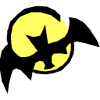 |
 |
... More on Intertextuality
Allusion, parodies and pastiches are all forms of intertextual connections
affecting meaning, and parodies and pastiches usually involve fairly complex
links, acting at more than one linguistic level, between the two texts.
Below is a well-known nursery rhyme (first published in 1806 in Rhymes
for the Nursery) and a pastiche of it by Lewis Carroll  ,
from Alice's Adventures in Wonderland. We have highlighted the
changes from the first to the second version. ,
from Alice's Adventures in Wonderland. We have highlighted the
changes from the first to the second version.
|
Twinkle twinkle little star,
How I wonder what you are!
Up above the world so high,
Like a diamond in the sky!
(Ann Taylor 1782-1866)
(Jane Taylor 1783-1824)
|


|
Twinkle twinkle little bat!
How I wonder what you're at!
Up above the world you fly!
Like a teatray in the sky.
(Lewis Carroll 1832-98)
|
In pastiche and parody the similarities are as important as the differences.
The similarities establish the connection between the two texts. The differences
produce the humorous effects.
The similarities involve:
-
the grammatical structure: it is almost identical, apart from the
changes in lines 2 and 3,
-
the lexis: it is identical apart from the words marked,
-
the sound structure: because the words are repeated, it is trivial
to note that the sounds stay the same too, but note that the rhyme
scheme stays the same (AABB) even though the actual rhyme used in
lines 1 and 2 changes, and
-
the graphology: both poems use exclamation marks at line ends (though
Carroll uses more and varies their position from line to line).
The humour comes from changing 'star' and 'diamond' to 'bat' (which forces
the grammar and sound changes at the end of line 2) and 'teatray'. Bats,
although we might also wonder at them, are connotatively very different
from stars. Many people don't like bats, and so the cosy relationship
between parent and child in the original is subverted. We also get a resultant
semantic oddity because:
-
we don't normally associate bats with twinkling (though they do change
direction rapidly, which is an effect not unlike twinkling in some
respects), and
-
comparing bats with teatrays seems ludicrous (even though they may
both seem like flat objects when seen from a distance against the
light), whereas the comparison between stars and diamonds seems appropriate.
Nursery rhymes, with their obvious patterns, appear to be used by adults
to help young children derive pleasure from language patterning and language
play, and they are effectively our first introduction to poetry. The sort
of pastiche which Carroll produces is clearly related to the sorts of
jokes young children make up themselves ('Baa, baa green sheep, Have you
any grass?') and helps to teach children (and us) about how intertextuality
and humour works.
Note: The examples of intertextuality we have talked about all involve
some later piece of writing being connected to an earlier text which it
refers back to. Sometimes, though, for particular readers the relationship
might be the other way round (for example if you happen to come across
the Lewis Carroll lines first and the ones by the Taylor sisters second).
What would the consequences be, do you think? Does
this sort of intertextuality have the same sort of status as the kind
we have been referring to?
Once you've given these questions some consideration, check out our response
Our Answer
|

